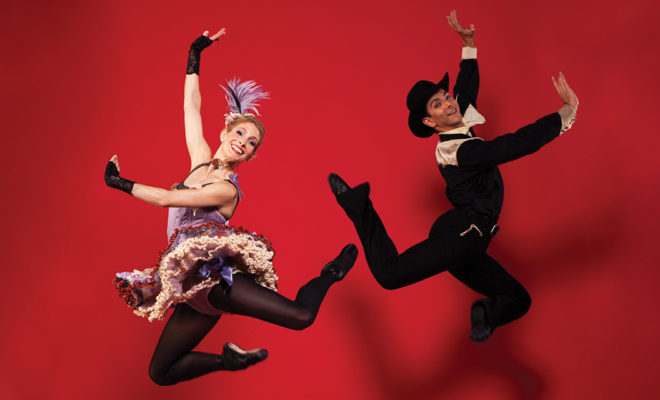
Arts & Culture
The Sarasota Ballet’s An Evening Both Light & Dark
By Sylvia Whitman | Photos by Frank Atura
The Sarasota Ballet’s presentation of Sir Kenneth MacMillan’s Las Hermanas stirs memories for Margaret Barbieri, the ballet’s assistant director and répétiteur. First staged in Stuttgart in 1963, the one-act tragedy captivated London audiences in 1971—with Barbieri dancing one of the three leads in the Royal Ballet’s original cast.
Based on The House of Bernardo Alba by Spanish playwright Federico Garcia Lorca, Las Hermanas explores the poisonous relationships of five sisters and their widowed mother in the 1930s, just before the Spanish Civil War. Cast as the sensual youngest sister in this oppressive household, Barbieri recalls the exhilarating challenge of dancing this character. Moving toward a window in the gloomy set, she wasn’t just bourréeing but looking and longing for the suitor to arrive.
“We weren’t just doing steps,” she says. “We were thinking of the people we were portraying.”
MacMillan oversaw the Royal Ballet’s performance, coaching Barbieri and the rest of the cast. Think about it: just one degree separates the renowned choreographer from The Sarasota Ballet. Although Barbieri isn’t staging the performance, she will be tutoring the dancers, and her advice comes straight from her firsthand experience.
Las Hermanas falls in the middle of The Sarasota Ballet’s otherwise upbeat November program, Symphonic Tales, an arrangement of three one-act ballets. The evening opens with choreographer George Balanchine’s Theme and Variations, set to a Tchaikovsky score. “It’s very regal and elegant, and very demanding technically,” says Barbieri. Born in St. Petersburg, Balanchine graduated from the Imperial Ballet School, and Theme and Variations reflects the choreographer’s professional upbringing. “It’s reminiscent of the Russian Imperial style,” says Barbieri.
Another Balanchine ballet, Western Symphony, serves as the closer, tipping a ten-gallon hat to the choreographer’s adopted country. It’s a frontier hoedown in ballet, a celebration of American exuberance. “You have your cowboys and dance-hall ladies,” says Barbieri. “He used folk music and folk dance.” Broadway and ballet composer Hershy Kay arranged the tunes.
Strategically placed on the program between Balanchine’s cheerful roots and wings, Las Hermanas snares the audience in an all-too-real thicket of desire thwarted by circumstance. For the lead ballerinas, it’s a full mind-body workout. ” says Barbieri. “You’re so exhausted—not from the technicality, but from the emotion.”
Dancers, she explains, need to “find the choreography” even as the score—Frank Martin’s Concerto for Harpsicord and Small Orchestra—demands full attention. “Musically it’s quite difficult,” she says, “but I found it helpful to have such a strong story line.” Two of the sisters—“we used to call them the mice,” says Barbieri—have small parts, but the eldest, middle, and youngest sisters are complex characters. MacMillan encouraged the dancers to find things for themselves—to act as well as dance.
Without overacting.
“He got angry if people overplayed it,” says Barbieri with a laugh. “This was a famous line he always said: ‘It’s all in my choreography. You don’t have to do anything extra.’”
Barbieri agrees. As the controlling mother maneuvers to marry off her brood, the eldest sister’s pas de deux reveals a very rigid, embittered young woman. She dances with clenched fists. “The choreography describes her character very well. She’s afraid of sex. She wants to be tempted, yet she can’t be,” explains Barbieri. “The younger sister, who’s beautiful and has a sense of her sexuality—her choreography shows that off. Then you have the middle sister, the spiteful one, and her choreography is all sharp and strong. She’s always spying.”
The dramatic narrative of Las Hermanas comes with a caution in the program book that the ballet explores themes for a “mature audience.”
“There was a slightly dark side to some of Sir Kenneth’s ballets,” Barbieri notes. He was able to plumb the misery of this family and create a work of art both “powerful” and “relevant,” she says.
As part of a company touring Las Hermanas, Barbieri remembers encountering this psychological drama play out in real time. When their bus stopped at a roadside restaurant in Portugal, the cast gasped as the proprietor’s two daughters—the elder homely, with a unibrow, the younger attractive and flaunting it—vied for a man under the stern gaze of their mother.
The Sarasota Ballet first staged Las Hermanas in the 2007-2008 season, and, despite its grim plot, aficionados have asked for its return. This year’s cast enjoys an advantage. Not only does The Sarasota Ballet now have a live rehearsal pianist, Anastasiya Poff, but she also plays the harpsichord.
And they have an empathetic ballet mistress in Barbieri. “It’s hard for dancers who’ve only done technical roles,” she says. “But it’s challenging and rewarding.”
Barbieri believes the range of the three one-acts in November will appeal both to subscribers diving deep into the season and dabblers just dipping in a toe. “It’s a great program for new people to come to because there’s something there for everyone,” she says.
First, in Theme and Variations, “you’ve got the majestic imperial Russian styled ballet. It’s very elegant and beautiful and what everyone thinks of as ballet—the tutus and the chandeliers.”
Las Hermanas introduces MacMillan’s dark theatrics. “I think it’s going to be appreciated by a lot of scholars who know the piece. And anyone can really be taken by the drama in the story.”
Finally, Western Symphony shows off Balanchine’s playful side. The evening ends with “fun…a little bit of folk song and dance,” Barbieri says. “You know, send everybody home happy.”
SYMPHONIC TALES, The Sarasota Ballet’s second program, runs November 22 – 23, 2019, at the Sarasota Opera House, accompanied by the Sarasota Orchestra. It encompasses:
Theme and Variations
Choreography by George Balanchine
Music by Pyotr Ilyich Tchaikovsky
Las Hermanas
Choreography by Sir Kenneth MacMillan
Music by Frank Martin
Western Symphony (Company Premiere)
Choreography by George Balanchine
Music—American folk tunes arranged by Hershy Kay
For tickets, call 941.359.0099 or visit sarasotaballet.org.




You must be logged in to post a comment Login